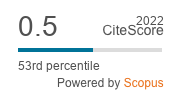Psycholinguistic Aspects of the Development of Students’ Critical Approach to the Solution of Terminological Problems in Online Translation Learning
DOI:
https://doi.org/10.29038/eejpl.2021.8.2.cheKeywords:
analytical and thinking activity, critical approach, decision-making, machine translation, online teaching, post-editing, problem solution, specialised translation, terminologyAbstract
The research is aimed at exploring the approaches to increase the efficiency of the development of the future translators’ critical approach to the solution of terminological problems, as well as the specialized bilingual (English and Ukrainian) terminology acquisition, in online teaching and learning. The method of research is based on the assumption that the said increase can be achieved through the intensification of the students’ analytical and thinking activity in their independent work by means of post-editing the machine-translated target texts combined with the simultaneous written explanation of the reasons for the respective corrections. This assumption was tested in the pilot experimental online teaching of specialised (in the domain of Psychology) translation to the first-year MA students majoring in Translation. The participants’ performance assessment took into account the amount of the independent work done by them, the level of their critical approach, as well as the specialised terminology usage accuracy in the final translation test. The results of the analysis proved the apparent dependence of the participants’ critical approach to the solution of terminological problems and the efficiency of specialised terminology acquisition on the intensity of their analytical and thinking activity in their independent work. The advantage of the participants with the highest level of the said intensity over those with the average one amounted to 16%, and 40% – over those with the lowest intensity. The efficiency of the development of students’ critical approach to the solution of terminological problems and the specialised terminology acquisition in online translation teaching and learning may be increased by intensification of their analytical and thinking activity in the process of meaningful post-editing of machine-translated target texts.
Downloads
References
Carl, M. & Schaeffer, M. J. (2017). Models of the Translation Process. In J. W. Schwieter & A. Ferreira (Eds.), The Handbook of Translation and Cognition (pp. 50–70). John Wiley & Sons, Inc. https://doi.org/10.1002/9781119241485.ch3
CEFR: The Common European Framework of Reference for Languages: Learning, Teaching, Assessment. Companion volume with new descriptors. (2018). Cambridge : Cambridge University Press.
Cifuentes-Ferez P. & Rojo, A. (2015). Thinking for Translating. Think-aloud Protocol on the translation of manner-of-motion verbs. Target, 27(2), 273–300. https://doi.org/10.1075/target.27.2.05cif
Englund Dimitrova, T. (2016). Translation process. In Y. Gambier & L. van Doorslaer (Eds.). Handbook of Translation Studies (Vol. 1) (pp. 406–411). Amsterdam : John Benjamins. https://doi.org/10.1075/hts.2016.tra6
Esqueda, M. D. (2021). Machine translation: teaching and learning issues. Trabalhos em Linguística Aplicada, 60(1), 282–299.
Jakobsen, A. L. (2017). Translation Process Research. In J. W. Schwieter & A. Ferreira (Eds.), The Handbook of Translation and Cognition (pp. 19-49). John Wiley & Sons, Inc. https://doi.org/10.1002/9781119241485.ch2
Künzli, A. (2009). Think-aloud Protocols – A Useful Tool for Investigating the Linguistic Aspect of Translation. Meta, 54(2), 326–341. https://doi.org/10.7202/037684ar
Kussmaul, P. & Tirkkonen-Condit, S. (1995). Think-Aloud Protocol Analysis in Translation Studies. TTR, 8(1), 177–199. https://doi.org/10.7202/037201ar
Lee, S. B. (2018). Process research into post-editing: How do undergraduate students post-edit the output of Google Translate? The Journal of Translation Studies, 19(3), 259-286. https://doi.org/10.15749/jts.2018.19.3.010
Lörscher, W. (2008). A Model for the Analysis of Translation Processes within a Framework of Systemic Linguistics. Cadernos de Tradução, 2(10), 97–112. DOI: 10.5007/6146
Mellinger, Ch. D. (2017). Translators and machine translation: knowledge and skills gaps in translator pedagogy. The Interpreter and Translator Trainer, 11(4). 280–293. https://doi.org/10.1080/1750399X.2017.1359760
Moorkens, J. (2018). What to expect from Neural Machine Translation: a practical in-class translation evaluation exercise. The Interpreter and Translator Trainer, 12(4), 375–387. https://doi.org/10.1080/1750399X.2018.1501639
Nord, C. (2016). Skopos and (Un)certainty: How Functional Translators Deal with Doubt. Meta, 61(1), 29–41. https://doi.org/10.7202/1036981ar
O’Brien, Sh., Rossetti, A. (2020). Neural machine translation and the evolution of the localisation sector. The Journal of Internationalization and Localization, 7(1-2), 95–121. https://doi.org/10.1075/jial.20005.obr
Pym, A. (2013). Translation Skill-Sets in a Machine-Translation Age. Meta, 58(3), 487–503. https://doi.org/10.7202/1025047ar
Schwieter, J. W. & Ferreira, A. (Eds). (2017). The Handbook of Translation and Cognition. John Wiley & Sons, Inc. https://doi.org/10.1002/9781119241485
Wu, D. & Wei, L. (2021). Online teaching as the new normal: Understanding translator trainers’ self-efficacy beliefs. The Journal of Specialised Translation, 36b, 301–326.
Yang, Y., Wang, X. & Yuan, Q. (2021). Measuring the usability of machine translation in the classroom context. Translation and Interpreting Studies, 16(1), 101–123. https://doi.org/10.1075/tis.18047.yan












 Creative Commons «Attribution» 4.0
Creative Commons «Attribution» 4.0